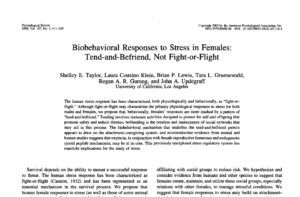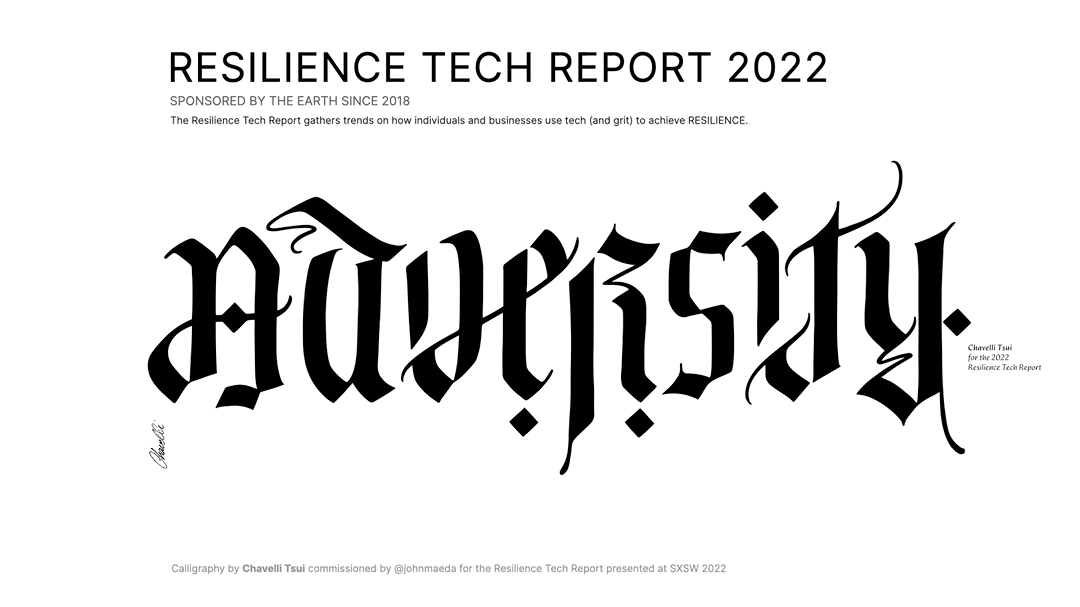The state of brittleness in our world is the outcome of an efficiency mindset that has long been prevalent. But competing is now about RESILIENCE more than efficiency, and that will be a tough transition to accept. —JM
Resilience Tech Report 2022
I’ll be revising the PDF over the year as I find errors and/or append new things. Thanks for visiting! —JM
Personal (and Professional)
Resilience is something that matters to you at an individual level. The technologies that support both psychological and physical resilience are evolving.
THE CHALLENGE
Enterprise (and Non-Profit Enterprise)
With the launch of Everbridge’s Best in Enterprise Resilience™ there’s a clear interest in major organizations to become more resilient with new technologies.
THE RISING HOPE
Government (and Community)
The responsibility of countries, states, cities is to keep their people free of harm to sustain stable livelihoods. Climate change has made technology a new necessity.
THE NEW NORMAL
Why has resilience become a 21st century requirement?
We’ve become aware of the fragile world in which we live our lives, in which for-profits and non-profits operate, and in which governments shepherd their communities. The global pandemic and other major disastrous events in our world have raised the awareness of ever-present threats that we’ve sought to ignore.
What’s the “Resilience Tech” Report?
Technologies for achieving greater personal, enterprise, and community resilience have been steadily on the rise due to macroscopic shifts in climate change, societal disruptions, and digital transformation. In the inaugural #ResilienceTech Report, Maeda highlights the growing business ecosystem being built by a new breed of technologists around the world who intend to bring greater resilience to individuals, organizations, and entire countries. Beyond techies, this report will appeal to a broad audience due to Covid-19’s impact on every individual’s sense of vulnerability.
The #ResilienceTech Report 2022: “The Hazard Zoography” builds on two past report series that correctly predicted three industry directions that were emergent throughout the digital transformation boom.
- The centrality of design in digital consumer and enterprise products.
- The paradigm of remote work and its potentially equalizing effects.
- The shifts to AI/ML as intrinsically needing more inclusive design.
This new report starts where the last ones left off: on the topic of our earth and where it’s taken us, and where humanity’s taking the earth.
- There are identifiable risks that impact your vitality or mortality, your company’s failure or success, and your country’s downturns or prosperity.
- The sun, the moon, and the earth’s molten core are all you need to know how natural hazards happen. And you can’t do anything about it — so relax.
- Digital transformation means computational experiences are core to private and public sectors. The Cyber Bees join the Black Swans and Gray Rhinos.
This new report is the third iteration in an evolution of my habit to make public annual reports that are shared at SXSW. It started with the first “Design in Tech” Report in 2015, and segued into the “CX” Report in 2020. This journey has spanned close to ten years nows. And I hope to be resilient in continuing this side hobby of mine until I’m no longer resilient … one day :+).
Zoography?
The computational experience (CX) now fully spans both digital and physical domains — especially due to the “forced” digital transformation that’s been led by COVID-19. Achieving resilience in the face of unrelenting adversity is our daily challenge, and the best way to thrive in the new landscape is to know the unpredictable “animals” that roam both digital and physical earths today: from Black Swans to Gray Rhinos to Cyber Bees.

New: Blog posts
- The Implicit Driver Of Resilience: The Neuroscience of Self-Renewal

- Diagnosing Enterprise Resilience (2003)

- After the 2022 report went live, new information flowed in
- Fight-or-Flight is apparently a male-ism. Tend-and-Befriend brings a whole different view to light.

- 2022 Resilience Tech Report Preview

What are the past reports by @johnmaeda?
Design in Tech Reports (2015-2019)
Today’s most beloved technology products and services balance design and engineering in a way that perfectly blends form and function. And as a result, over the short span of a decade there’s now a few tech industry players that tower over long established non-tech industry players — specifically the ones who have not managed to compete at the speed of Moore’s law alongside their tech counterparts. Think Amazon versus Walmart. Think Uber versus the taxi companies. Think self-driving trucks versus truck drivers. The net result is a degree of unprecedented prosperity by tech companies running at exponential speeds and with no sign of tiring. Massive computational machines working alongside the technorati have left in their wake many traditional industries that are literally dying to keep up.
Design in the technology industry, or “Design in Tech” as we’ve called it, has vastly transformed how businesses translate value into experiences. Whether in the WOW of how digital marketing can synthesize interactive, customized content at the individualized level, or whether in the “after WOW” of a digital product’s post on-boarding flow where many weeks later you whisper to yourself with proud admiration, “Wow.” Tech startups have historically had an easier journey to success in crafting both the wows and the after wows because they’ve been advantaged by building mobile-first, cloud-first, and Millennial-first. And let’s not forget that startups have little to lose when they’re starting up, so they have tremendous latitude to experiment and “fail fast.”
CX Reports (2020-2021)
The ability to give consumers a holistic experience is challenging, if not impossible, when you’re bigger than a startup. Bringing design into the early phases of technology startups resulted in billions of dollars of unexpected value creation for companies like Airbnb, Pinterest, and Lyft. And for the established tech companies like Google, Microsoft, and Facebook who later invested heavily in design through acquisitions and massive talent acquisitions, their continue domination was fortified.
But when you’re instead a non-tech “endup” company running at full scale with thousands of people bearing the pressure of serving millions of customers, making a delightful experience will naturally end up at the bottom of your list. Why? Because so many parts of an organization need to be involved in creating and maintaining these newer, realtime integrated experiences-as-services. So there’s a need for new mindsets, new skills, new dreams, and new budgets with which a few new bets can be made. And these new directives need to have the permission to fail — which is often difficult because the stakes are significantly higher in endups (or “grownups”).
Need to learn how the cloud and AI/ML really work?

How To Speak Machine (2019), Penguin Books
Computational Thinking For The Rest Of Us
I spent six years trying to figure out how to explain computation to a business-minded layperson. The net result is a book in six sections that explains the three properties of computation as a kind of “alien life form” (as David Bowie called it); the latter three sections explain why digital products are so intrinsically different than ones we knew before the Internet.
